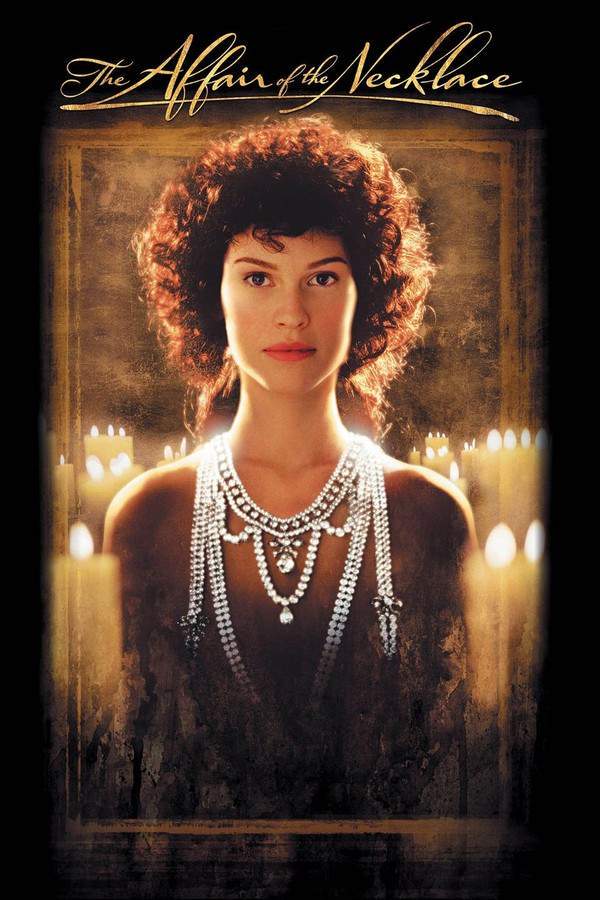Jefferson in Paris 1995

While serving as the American ambassador to France in the 1780s, Thomas Jefferson, still mourning his wife, becomes entangled in a passionate relationship with artist Maria Cosway. His personal life is further complicated by the arrival of his daughter and her enslaved companion, Sally Hemings. Navigating the lavish world of 18th-century Paris, Jefferson must reconcile his duties, his desires, and the challenging realities of love, family, and the societal constraints of the era.
Does Jefferson in Paris have end credit scenes?
No!
Jefferson in Paris does not have end credit scenes. You can leave when the credits roll.
Meet the Full Cast and Actors of Jefferson in Paris
Explore the complete cast of Jefferson in Paris, including both lead and supporting actors. Learn who plays each character, discover their past roles and achievements, and find out what makes this ensemble cast stand out in the world of film and television.
External Links and Streaming Options
Discover where to watch Jefferson in Paris online, including streaming platforms, rental options, and official sources. Compare reviews, ratings, and in-depth movie information across sites like IMDb, TMDb, Wikipedia or Rotten Tomatoes.
Ratings and Reviews for Jefferson in Paris
See how Jefferson in Paris is rated across major platforms like IMDb, Metacritic, and TMDb. Compare audience scores and critic reviews to understand where Jefferson in Paris stands among top-rated movies in its genre.

45
Metascore
5.8
User Score


31%
TOMATOMETER

35%
User Score

5.7 /10
IMDb Rating

52
%
User Score
Take the Ultimate Jefferson in Paris Movie Quiz
Challenge your knowledge of Jefferson in Paris with this fun and interactive movie quiz. Test yourself on key plot points, iconic characters, hidden details, and memorable moments to see how well you really know the film.
Exploring Jefferson in Paris: Test your knowledge of Thomas Jefferson's complex life and diplomatic efforts during his time in France with this quiz.
Who plays the role of Thomas Jefferson in the film?
Nick Nolte
James Earl Jones
Tom Wilkinson
Anthony Valentine
Show hint
Full Plot Summary and Ending Explained for Jefferson in Paris
Read the complete plot summary of Jefferson in Paris, including all major events, twists, and the full ending explained in detail. Explore key characters, themes, hidden meanings, and everything you need to understand the story from beginning to end.
An understated yet captivating portrayal of historical events featuring an exceptional cast, Jefferson in Paris showcases the significant years from 1784 to 1789, when the American actor Nick Nolte embodies Thomas Jefferson, the United States Minister to France during the early days of the French Revolution.
The narrative begins decades later in the Midwest, where a journalist ventures far and wide to interview Madison Hemings, Jefferson’s wayward son, played by James Earl Jones. Madison shares poignant insights, highlighting that Jefferson died in financial ruin, with his mother Sally and uncle James revealing their connections to Jefferson’s late wife, Martha.
While the film does not depict it, we learn that John Wales, Jefferson’s father-in-law, was a Virginia slave trader and prominent statesman who left Jefferson his estate and slaves upon his passing in 1773. Furthermore, Jefferson and Martha had six children, yet only two daughters lived into adulthood.
Upon arriving in Paris, Jefferson takes his eldest surviving daughter, Martha “Patsy” Jefferson, portrayed by Gwyneth Paltrow, and enrolls her in a Catholic academy for girls. Despite being Protestant, Patsy is allowed to maintain her beliefs and integrity among her peers.
Throughout his time in Europe, Jefferson grapples with a debt-ridden Congress and significant financial obligations due to French military aid during the American Revolution. He mingles with influential figures like the adversarial British Ambassador, played by Anthony Valentine, and the regal King Louis XVI (Michael Lonsdale) and Queen Marie Antoinette (Charlotte de Turckheim). Amidst this, he seeks loans from Dutch bankers to sustain the American government.
The film uses the extravagant costumes and rituals of the French elite, creating a satire that illustrates Jefferson’s role as a key player in shaping America’s history. This makes the film an excellent educational piece for high school and college students, challenging them to look beyond the superficialities of aristocratic life to focus on the substantial political victories and shortcomings.
The stark disparity between the opulent French elite and the struggling common people is highlighted, as peasants face starvation amidst the king and queen’s luxurious existence. While Jefferson is in Paris, tensions rise with the onset of the French Revolution.
James Hemings, portrayed by Seth Gilliam, is an educated slave and Jefferson’s manservant who works alongside skilled chefs in Jefferson’s kitchen. His introduction to distilled spirits, initially rejected due to his financial constraints, becomes a turning point in his life in France—a land where slavery has no place. Jefferson’s encouragement leads James to seek compensation, as he realizes that he is not bound by the same laws that restrict his education back in America.
Patsy, like her father, falls into a gloomy state of homesickness and beseeches Jefferson to bring their younger daughter Polly to Paris. When Polly (Estelle Eonnet) arrives, she is accompanied by Jefferson’s teenage slave and maidservant, Sally Hemings, played by Thandy Newton.
Through Nick Nolte’s remarkable performance, Thomas Jefferson emerges as a dynamic statesman plagued by personal struggles. His romantic entanglement with Maria Cosway, the wife of a nobleman (played by Simon Callow), adds complexity to his character. Jefferson’s adventurous spirit leads him to a minor injury during a horseback ride, which serves as a metaphor for his tumultuous life.
Director James Ivory offers an intimate glimpse into Jefferson’s psyche, portraying him as a widower wrestling with despair, with emotional pain beautifully captured on screen. The tender bond between him and Sally Hemings evolves, hinting at an undeniable affection nurtured by their shared experiences.
As the narrative unfolds, confrontations arise among the various women in Jefferson’s life, adding to the film’s depth. Despite being a story with heavy themes like slavery, polygamy, and unacknowledged lineage, Jefferson faces these issues with a sense of courage and charisma.
At a pivotal moment, when confronted with Sally’s pregnancy by her brother James, Jefferson calls upon his daughter Patsy to witness his solemn promise to emancipate them eventually upon their return to Virginia, thereby raising the dramatic stakes.
The film concludes with updates about Jefferson’s political journey and his controversial relationship with Sally Hemings, a relationship not fully explored onscreen but crucial for understanding the context of his life.
It’s significant to note that following his return to Virginia in 1789 with his daughters and slaves, Jefferson was invited by President Washington to join his Cabinet as Secretary of State, a role he embraced from 1790 to 1793. His political endeavors continued with a presidential campaign in 1796, and despite losing to John Adams, he became Vice President until he eventually secured the presidency in 1801.
Jefferson’s leadership marked the inclusion of new states while advocating against slavery in the territories. He also facilitated the Louisiana Purchase, dramatically expanding the United States’ land holdings. Serving as president for two terms, he was a peaceful yet assertive leader who handled foreign threats decisively.
Standing nearly 6 foot 3 inches tall, Jefferson was an imposing figure whose intellect and physical presence commanded respect among allies and adversaries alike. Biographer James Parton once noted that Jefferson possessed an exceptional skill set, capable of numerous trades and talents, which are echoed throughout Nolte’s portrayal.
Jefferson in Paris ultimately paints Jefferson not just as a political figure but as a complex human being, whose personal imperfections juxtapose his revolutionary ideals and his significant role in American history. He represents a blend of elegance and simplicity, merging diplomacy and powerful rhetoric, all while leaving a lasting legacy as the principal author of The Declaration of Independence. Indeed, the film’s stunning visuals capture his renowned calligraphy skills, showcasing his brilliance both on and off the page.
Uncover the Details: Timeline, Characters, Themes, and Beyond!

Coming soon on iOS and Android
The Plot Explained Mobile App
From blockbusters to hidden gems — dive into movie stories anytime, anywhere. Save your favorites, discover plots faster, and never miss a twist again.
Sign up to be the first to know when we launch. Your email stays private — always.
Watch Trailers, Clips & Behind-the-Scenes for Jefferson in Paris
Watch official trailers, exclusive clips, cast interviews, and behind-the-scenes footage from Jefferson in Paris. Dive deeper into the making of the film, its standout moments, and key production insights.
Jefferson in Paris Themes and Keywords
Discover the central themes, ideas, and keywords that define the movie’s story, tone, and message. Analyze the film’s deeper meanings, genre influences, and recurring concepts.
Jefferson in Paris Other Names and Titles
Explore the various alternative titles, translations, and other names used for Jefferson in Paris across different regions and languages. Understand how the film is marketed and recognized worldwide.
Similar Movies To Jefferson in Paris You Should Know About
Browse a curated list of movies similar in genre, tone, characters, or story structure. Discover new titles like the one you're watching, perfect for fans of related plots, vibes, or cinematic styles.
Quick Links: Summary, Cast, Ratings, More

What's After the Movie?
Not sure whether to stay after the credits? Find out!
Explore Our Movie Platform
New Movie Releases (2025)
Famous Movie Actors
Top Film Production Studios
Movie Plot Summaries & Endings
Major Movie Awards & Winners
Best Concert Films & Music Documentaries
Movie Collections and Curated Lists
© 2025 What's After the Movie. All rights reserved.































